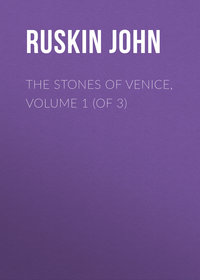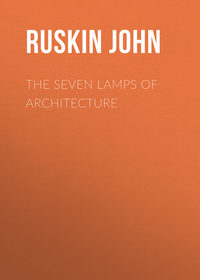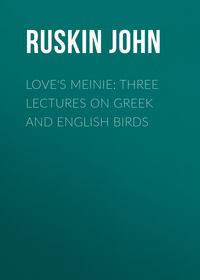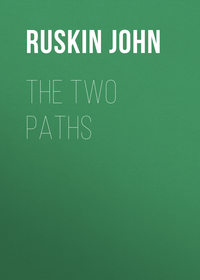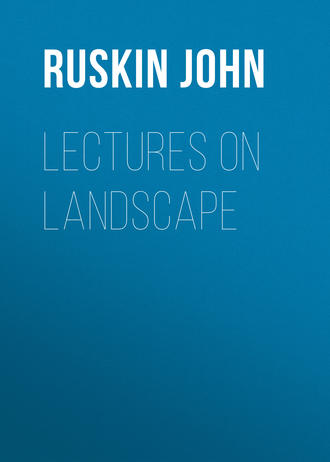 полная версия
полная версияLectures on Landscape
23. Also, observe that as your representing this limit by a dark line is a conventionalism, and just as much a conventionalism when the line is subtle as when it is thick, the great masters accept and declare that conventionalism with perfect frankness, and use bold and decisive outline, if any.
Also, observe, that though, when you are master of your art, you may modify your outline by making it dark in some parts, light in others, and even sometimes thick and sometimes slender, a scientifically accurate outline is perfectly equal throughout; and in your first practice I wish you to use always a pen with a blunt point, which will make no hair stroke under any conditions. So that using black ink and only one movement of the pen, not returning to thicken your line, you shall either have your line there, or not there; and that you may not be able to gradate or change it, in any way or degree whatsoever.
24. Now the first question respecting it is: what place is your thick line to have with respect to the limit which it represents—outside of it, or inside, or over it? Theoretically, it is to be over it; the true limit falling all the way along the center of your thick line. The contest of Apelles with Protogenes consisted in striking this true limit within each other's lines, more and more finely. And you may always consider your pen line as representing the first incision for sculpture, the true limit being the sharp center of the incision.
But, practically, when you are outlining a light object defined against a dark one, the line must go outside of it; and when a dark object against a light one, inside of it.
In this drawing of Holbein's, the hand being seen against the light, the outline goes inside the contour of the fingers.
25. Secondly. And this is of great importance. It will happen constantly that forms are entirely distinct from each other and separated by true limits, which are yet invisible, or nearly so, to the eye. I place, for instance, one of these eggs in front of the other, and probably to most of you the separation in the light is indiscernible. Is it then to be outlined? In practically combining outline with accomplished light and shade there are cases of this kind in which the outline may with advantage, or even must for truth of effect, be omitted. But the facts of the solid form are of so vital importance, and the perfect command of them so necessary to the dignity and intelligibility of the work, that the greatest artists, even for their finished drawings, like to limit every solid form by a fine line, whether its contour be visible to the eye or not.
26. An outline thus perfectly made with absolute decision, and with a wash of one color above it, is the most masterly of all methods of light and shade study, with limited time, when the forms of the objects to be drawn are clear and unaffected by mist. But without any wash of color, such an outline is the most valuable of all means for obtaining such memoranda of any scene as may explain to another person, or record for yourself, what is most important in its features.
27. Choose, then, a subject that interests you; and so far as failure of time or materials compels you to finish one part, or express one character, rather than another, of course dwell on the features that interest you most. But beyond this, forget, or even somewhat repress yourself, and make it your first object to give a true idea of the place to other people. You are not to endeavor to express your own feelings about it; if anything, err on the side of concealing them. What is best is not to think of yourself at all, but to state as plainly and simply as you can the whole truth of the thing. What you think unimportant in it may to another person be the most touching part of it: what you think beautiful may be in truth commonplace and of small value. Quietly complete each part to the best of your power, endeavoring to maintain a steady and dutiful energy, and the tranquil pleasure of a workman.
II.
LIGHT AND SHADE
28. In my last Lecture I laid before you evidence that the greatness of the master whom I wished you to follow as your only guide in landscape depended primarily on his studying from Nature always with the point; that is to say, in pencil or pen outline. To-day I wish to show you that his preëminence depends secondarily on his perfect rendering of form and distance by light and shade, before he admits a thought of color.
I say "before" however—observe carefully—only with reference to the construction of any given picture, not with reference to the order in which he learnt his mechanical processes. From the beginning, he worked out of doors with the point, but indoors with the brush; and attains perfect skill in washing flat color long before he attains anything like skill in delineation of form.
29. Here, for instance, is a drawing, when he was twelve or thirteen years old, of Dover Castle and the Dover Coach; in which the future love of mystery is exhibited by his studiously showing the way in which the dust rises about the wheels; and an interest in drunken sailors, which materially affected his marine studies, shown not less in the occupants of the hind seat. But what I want you to observe is that, though the trees, coach, horses, and sailors are drawn as any schoolboy would draw them, the sky is washed in so smoothly that few water-color painters of our day would lightly accept a challenge to match it.
And, therefore, it is, among many other reasons, that I put the brush into your hands from the first, and try you with a wash in lampblack, before you enter my working class. But, as regards the composition of his picture, the drawing is always first with Turner, the color second.
30. Drawing: that is to say, the expression by gradation of light, either of form or space. Again I thus give you a statement wholly adverse to the vulgar opinion of him. You will find that statement early in the first volume of "Modern Painters," and repeated now through all my works these twenty-five years, in vain. Nobody will believe that the main virtue of Turner is in his drawing. I say "the main virtue of Turner." Splendid though he be as a colorist, he is not unrivaled in color; nay, in some qualities of color he has been far surpassed by the Venetians. But no one has ever touched him in exquisiteness of gradation; and no one in landscape in perfect rendering of organic form.
31. I showed you in this drawing, at last Lecture, how truly he had matched the color of the iron-stained rocks in the bed of the Ticino; and any of you who care for color at all cannot but take more or less pleasure in the black and greens and warm browns opposed throughout. But the essential value of the work is not in these. It is, first, in the expression of enormous scale of mountain and space of air, by gradations of shade in these colors, whatever they may be; and, secondly, in the perfect rounding and cleaving of the masses alike of mountain and stone. I showed you one of the stones themselves, as an example of uninteresting outline. If I were to ask you to paint it, though its color is pleasant enough, you would still find it uninteresting and coarse compared to that of a flower, or a bird. But if I can engage you in an endeavor to draw its true forms in light and shade, you will most assuredly find it not only interesting, but in some points quite beyond the most subtle skill you can give to it.
32. You have heard me state to you, several times, that all the masters who valued accurate form and modeling found the readiest way of obtaining the facts they required to be firm pen outline, completed by a wash of neutral tint. This method is indeed rarely used by Raphael or Michael Angelo in the drawings they have left us, because their studies are nearly all tentative—experiments in composition, in which the imperfect or careless pen outline suggested all they required, and was capable of easy change without confusing the eye. But the masters who knew precisely before they laid touch on paper what they were going to do—and this may be, observe, either because they are less or greater than the men who change; less, in merely drawing some natural object without attempt at composition, or greater in knowing absolutely beforehand the composition they intend; it may be, even so, that what they intend, though better known, is not so good:—but at all events, in this anticipating power Tintoret, Holbein and Turner stand, I think, alone as draughtsmen; Tintoret rarely sketching at all, but painting straight at the first blow, while Holbein and Turner sketch indeed, but it is as with a pen of iron and a point of diamond.
33. You will find in your educational series6 many drawings illustrative of the method; but I have enlarged here the part that is executed with the pen, out of this smaller drawing, that you may see with what fearless strength Holbein delineates even the most delicate folds of the veil on the head, and of the light muslin on the shoulders, giving them delicacy, not by the thinness of his line, but by its exquisite veracity.
The eye will endure with patience, or even linger with pleasure, on any line that is right, however coarse; while the faintest or finest that is wrong will be forcibly destructive. And again and again I have to recommend you to draw always as if you were engraving, and as if the line could not be changed.
34. The method used by Turner in the Liber Studiorum is precisely analogous to that of Holbein. The lines of these etchings are to trees, rocks, or buildings, absolutely what these of Holbein are; not suggestions of contingent grace, but determinations of the limits of future form. You will see the explanatory office of such lines by placing this outline over my drawing of the stone, until the lines coincide with the limits of the shadow. You will find that it intensifies and explains the forms which otherwise would have escaped notice, and that a perfectly gradated wash of neutral tint with an outline of this kind is all that is necessary for grammatical statement of forms. It is all that the great colorists need for their studies; they would think it wasted time to go farther; but, if you have no eye for color, you may go farther in another manner, with enjoyment.
35. Now to go back to Turner.
The first great object of the Liber Studiorum, for which I requested you in my sixth Lecture7 to make constant use of it, is the delineation of solid form by outline and shadow. But a yet more important purpose in each of the designs in that book is the expression of such landscape powers and character as have especial relation to the pleasures and pain of human life—but especially the pain. And it is in this respect that I desired you (Sect. 172) to be assured, not merely of their superiority, but of their absolute difference in kind from photography, as works of disciplined design.

NEAR BLAIR ATHOL.
From the painting by Turner.
36. I do not know whether any of you were interested enough in the little note in my catalogue on this view near Blair Athol, to look for the scene itself during your summer rambles. If any did, and found it, I am nearly certain their impression would be only that of an extreme wonder how Turner could have made so little of so beautiful a spot. The projecting rock, when I saw it last in 1857, and I am certain, when Turner saw it, was covered with lichens having as many colors as a painted window. The stream—or rather powerful and deep Highland river, the Tilt—foamed and eddied magnificently through the narrowed channel; and the wild vegetation in the rock crannies was a finished arabesque of living sculpture, of which this study of mine, made on another stream, in Glenfinlas, only a few miles away, will give you a fair idea. Turner has absolutely stripped the rock of its beautiful lichens to bare slate, with one quartz vein running up through it; he has quieted the river into a commonplace stream; he has given, of all the rich vegetation, only one cluster of quite uninteresting leaves and a clump of birches with ragged trunks. Yet, observe, I have told you of it, he has put into one scene the spirit of Scotland.

DUMBLANE ABBEY.
From the painting by Turner.
37. Similarly, those of you who in your long vacations have ever stayed near Dumblane will be, I think, disappointed in no small degree by this study of the abbey, for which I showed you the sketch at last Lecture. You probably know that the oval window in its west end is one of the prettiest pieces of rough thirteenth-century carving in the kingdom; I used it for a chief example in my lectures at Edinburgh; and you know that the lancet windows, in their fine proportion and rugged masonry, would alone form a study of ruined Gothic masonry of exquisite interest.
Yet you find Turner representing the lancet window by a few bare oval lines like the hoop of a barrel; and indicating the rest of the structure by a monotonous and thin piece of outline, of which I was asked by one of yourselves last term, and quite naturally and rightly, how Turner came to draw it so slightly—or, we may even say, so badly.
38. Whenever you find Turner stopping short, or apparently failing in this way, especially when he does the contrary of what any of us would have been nearly sure to do, then is the time to look for your main lesson from him. You recollect those quiet words of the strongest of all Shakespeare's heroes, when any one else would have had his sword out in an instant:
"Keep up your bright swords, for the dew will rust them …Were it my cue to fight, I should have known itWithout a prompter."8Now you must always watch keenly what Turner's cue is. You will see his hand go to his hilt fast enough, when it comes. Dumblane Abbey is a pretty piece of building enough, it is true; but the virtue of the whole scene, and meaning, is not in the masonry of it. There is much better masonry and much more wonderful ruin of it elsewhere; Dumblane Abbey—tower and aisles and all—would go under one of the arches of buildings such as there are in the world. Look at what Turner will do when his cue is masonry,—in the Coliseum. What the execution of that drawing is you may judge by looking with a magnifying glass at the ivy and battlements in this, when, also, his cue is masonry. What then can he mean by not so much as indicating one pebble or joint in the walls of Dumblane?

39. I was sending out the other day, to a friend in America, a chosen group of the Liber Studiorum to form a nucleus for an art collection at Boston. And I warned my friend at once to guard his public against the sore disappointment their first sight of these so much celebrated works would be to them. "You will have to make them understand," I wrote to him, "that their first lesson will be in observing not what Turner has done, but what he has not done. These are not finished pictures, but studies; endeavors, that is to say, to get the utmost result possible with the simplest means; they are essentially thoughtful, and have each their fixed purpose, to which everything else is sacrificed; and that purpose is always imaginative—to get at the heart of the thing, not at its outside."
40. Now, it is true, there are beautiful lichens at Blair Athol, and good building at Dumblane; but there are lovely lichens all over the cold regions of the world, and there is far more interesting architecture in other countries than in Scotland. The essential character of Scotland is that of a wild and thinly inhabited rocky country, not sublimely mountainous, but beautiful in low rock and light streamlet everywhere; with sweet copsewood and rudely growing trees. This wild land possesses a subdued and imperfect school of architecture, and has an infinitely tragic feudal, pastoral, and civic history. And in the events of that history a deep tenderness of sentiment is mingled with a cruel and barren rigidity of habitual character, accurately corresponding to the conditions of climate and earth.
41. Now I want you especially to notice, with respect to these things, Turner's introduction of the ugly square tower high up on the left. Your first instinct would be to exclaim, "How unlucky that was there at all! Why, at least, could not Turner have kept it out of sight?" He has quite gratuitously brought it into sight; gratuitously drawn firmly the three lines of stiff drip-stone which mark its squareness and blankness. It is precisely that blank vacancy of decoration, and setting of the meager angles against wind and war, which he wants to force on your notice, that he may take you thoroughly out of Italy and Greece, and put you wholly into a barbarous and frost-hardened land; that once having its gloom defined he may show you all the more intensely what pastoral purity and innocence of life, and loveliness of nature, are underneath the banks and braes of Doune, and by every brooklet that feeds the Forth and Clyde.
That is the main purpose of these two studies. How it is obtained by various incidents in the drawing of stones, and trees, and figures, I will show you another time. The chief element in both is the sadness and depth of their effect of subdued though clear light in sky and stream.
42. The sadness of their effect, I repeat. If you remember anything of the Lectures I gave you through last year, you must be gradually getting accustomed to my definition of the Greek school in art, as one essentially Chiaroscurist, as opposed to Gothic color; Realist, as opposed to Gothic imagination; and Despairing, as opposed to Gothic hope. And you are prepared to recognize it by any one of these three conditions. Only, observe, the chiaroscuro is simply the technical result of the two others: a Greek painter likes light and shade, first, because they enable him to realize form solidly, while color is flat; and secondly, because light and shade are melancholy, while color is gay.
So that the defect of color, and substitution of more or less gray or gloomy effects of rounded gradation, constantly express the two characters: first, Academic or Greek fleshliness and solidity as opposed to Gothic imagination; and secondly, of Greek tragic horror and gloom as opposed to Gothic gladness.
43. In the great French room in the Louvre, if you at all remember the general character of the historical pictures, you will instantly recognize, in thinking generally of them, the rounded fleshly and solid character in the drawing, the gray or greenish and brownish color, or defect of color, lurid and moonlight-like, and the gloomy choice of subjects, as the Deluge, the Field of Eylau, the Starvation on the Raft, and the Death of Endymion; always melancholy, and usually horrible.
The more recent pictures of the painter Gérôme unite all these attributes in a singular degree; above all, the fleshliness and materialism which make his studies of the nude, in my judgment, altogether inadmissible into the rank of the fine arts.
44. Now you observe that I never speak of this Greek school but with a certain dread. And yet I have told you that Turner belongs to it, that all the strongest men in times of developed art belong to it; but then, remember, so do all the basest. The learning of the Academy is indeed a splendid accessory to original power, in Velasquez, in Titian, or in Reynolds; but the whole world of art is full of a base learning of the Academy, which, when fools possess, they become a tenfold plague of fools.
And again, a stern and more or less hopeless melancholy necessarily is under-current in the minds of the greatest men of all ages,—of Homer, Aeschylus, Pindar, or Shakespeare. But an earthy, sensual, and weak despondency is the attribute of the lowest mental and bodily disease; and the imbecilities and lassitudes which follow crime, both in nations and individuals, can only find a last stimulus to their own dying sensation in the fascinated contemplation of completer death.
45. Between these—the highest, and these—the basest, you have every variety and combination of strength and of mistake: the mass of foolish persons dividing themselves always between the two oppositely and equally erroneous faiths, that genius may dispense with law, or that law can create genius. Of the two, there is more excuse for, and less danger in the first than in the second mistake. Genius has sometimes done lovely things without knowledge and without discipline. But all the learning of the Academies has never yet drawn so much as one fair face, or ever set two pleasant colors side by side.
46. Now there is one great Northern painter, of whom I have not spoken till now, probably to your surprise, Rubens; whose power is composed of so many elements, and whose character may be illustrated so completely, and with it the various operation of the counter schools, by one of his pictures now open to your study, that I would press you to set aside one of your brightest Easter afternoons for the study of that one picture in the Exhibition of Old Masters, the so-called "Juno and Argus," No. 387.
So-called, I say; for it is not a picture either of Argus or of Juno, but the portrait of a Flemish lady "as Juno" (just as Rubens painted his family picture with his wife "as the Virgin" and himself "as St. George"): and a good anatomical study of a human body as Argus. In the days of Rubens, you must remember, mythology was thought of as a mere empty form of compliment or fable, and the original meaning of it wholly forgotten. Rubens never dreamed that Argus is the night, or that his eyes are stars; but with the absolutely literal and brutal part of his Dutch nature supposes the head of Argus full of real eyes all over, and represents Hebe cutting them out with a bloody knife and putting one into the hand of the goddess, like an unseemly oyster.
That conception of the action, and the loathsome sprawling of the trunk of Argus under the chariot, are the essential contributions of Rubens' own Netherland personality. Then the rest of the treatment he learned from other schools, but adopted with splendid power.
47. First, I think, you ought to be struck by having two large peacocks painted with scarcely any color in them! They are nearly black, or black-green, peacocks. Now you know that Rubens is always spoken of as a great colorist, par excellence a colorist; and would you not have expected that—before all things—the first thing he would have seen in a peacock would have been gold and blue? He sees nothing of the kind. A peacock, to him, is essentially a dark bird; serpent-like in the writhing of the neck, cloud-like in the toss and wave of its plumes. He has dashed out the filaments of every feather with magnificent drawing; he has not given you one bright gleam of green or purple in all the two birds.
Well, the reason of that is that Rubens is not par excellence a colorist; nay, is not even a good colorist. He is a very second-rate and coarse colorist; and therefore his color catches the lower public, and gets talked about. But he is par excellence a splendid draughtsman of the Greek school; and no one else, except Tintoret, could have drawn with the same ease either the muscles of the dead body or the plumes of the birds.
48. Farther, that he never became a great colorist does not mean that he could not, had he chosen. He was warped from color by his lower Greek instincts, by his animal delight in coarse and violent forms and scenes—in fighting, in hunting, and in torments of martyrdom and of hell: but he had the higher gift in him, if the flesh had not subdued it. There is one part of this picture which he learned how to do at Venice, the Iris, with the golden hair, in the chariot behind Juno. In her he has put out his full power, under the teaching of Veronese and Titian; and he has all the splendid Northern-Gothic, Reynolds or Gainsborough play of feature with Venetian color. Scarcely anything more beautiful than that head, or more masterly than the composition of it, with the inlaid pattern of Juno's robe below, exists in the art of any country. Si sic omnia!—but I know nothing else equal to it throughout the entire works of Rubens.
49. See, then, how the picture divides itself. In the fleshly baseness, brutality and stupidity of its main conception, is the Dutch part of it; that is Rubens' own. In the noble drawing of the dead body and of the birds you have the Phidias-Greek part of it, brought down to Rubens through Michael Angelo. In the embroidery of Juno's robe you have the Dædalus-Greek part of it, brought down to Rubens through Veronese. In the head of Iris you have the pure Northern-Gothic part of it, brought down to Rubens through Giorgione and Titian.




